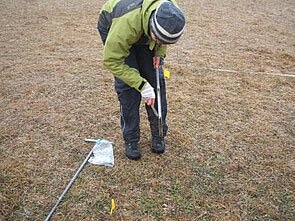The P cycle in grassland and forest ecosystems of different biodiversity and land-use intensity
Increasingly efficient nutrient exploitation with increasing plant diversity results in lower nutrient concentrations in soil solution. This was observed for nitrogen but not for other essential nutrients such as phosphorus. In managed ecosystems, diversity is closely linked to land-use intensity and history. To understand the controls of nutrient concentrations in soil, land-use and biodiversity effects must be disentangled. Therefore, DYNPHOS studies the effect of land use and biodiversity on phosphorus cycling in grassland and forest systems of the three Biodiversity Exploratories.
Our objective is to disentangle the effect of land use and plant diversity on
- Phosphorus fractions in soil
- Phosphorus cycling in soil
- Phosphorus storage in plants
Furthermore, we will assess the influence of land-use practices on phosphorus in soil by using novel isotope techniques, i.e. the determination of ?18O in phosphates.
With these goals we plan to test the following hypotheses
- Increasing land-use intensity probably associated with higher nutrient availability in soil
- results in a less strong relationship between biodiversity and P availability (organic and inorganic) in soil and
- will lead to a less strong relationship between biodiversity and P pools in plants.
-
- Intensive land use increases the proportion of fertilizer-derived easily-soluble P minerals. The concentration of P is to a large extent chemically controlled thereby reducing the effect of diversity on P concentrations in soil.
- At a given site fertility (within the same land use), increasing biomass production with increasing plant diversity results in an increasing size of the organic P pool and hence an increasing contribution of mineralized P to plant-available P. As a result the diversity effect on P availability will increase.
- The O isotope ratio in PO4 can be used to distinguish different P sources (dissolution of mineral P, desorption, mineralization).
We will determine P pools in soil and plant biomass, P release by dissolution and mineralization, and the isotopic signature (?18O) in phosphate extracted from soil.










